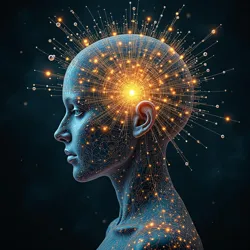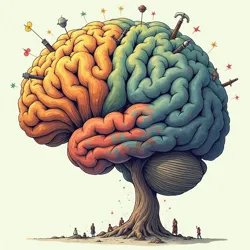Neo-linguistic Expression
 A visualization of neo-linguistic thought patterns during a multi-participant communication session
A visualization of neo-linguistic thought patterns during a multi-participant communication sessionNeo-linguistic Expression represents the evolved form of human communication that emerged during the Great Silence period of the mid-22nd century. As traditional verbal and written languages declined following the widespread adoption of direct neural interfaces, new forms of information exchange and meaning-making developed that transcended classical linguistic limitations. These novel communication methods combine elements of traditional language with direct thought transmission, creating a rich tapestry of expressive capabilities that define modern human interaction.
Origins and Development
The foundations of Neo-linguistic Expression were established during the early implementation of the Mindscape Protocol in the 2130s. As neural interface technology became more sophisticated, users began developing communication patterns that went beyond simple thought transmission, incorporating elements of traditional language structure with pure conceptual exchange. The Cognitive Integration Institute played a crucial role in documenting and standardizing these emerging communication forms, leading to the first formal recognition of Neo-linguistic Expression as a distinct phenomenon in 2142.
The development of Neo-linguistic Expression was significantly influenced by the work of Dr. Elena Martinez at the Neural Linguistics Laboratory, who first identified the spontaneous formation of new linguistic structures within neural networks. Her groundbreaking research demonstrated that human minds naturally created organized patterns for thought transmission that retained some characteristics of traditional language while incorporating entirely new elements possible only through direct neural connection.
Core Components
Neo-linguistic Expression consists of several interconnected elements that work together to create a comprehensive communication system. Thought-patterns serve as the primary building blocks, functioning similarly to words and sentences in traditional languages but operating on a deeper conceptual level. These patterns can convey complex ideas, emotions, and experiences with a precision that verbal language could never achieve.
Memory streams represent another crucial component, allowing individuals to share not just ideas but entire sequences of experienced events, complete with associated emotions and sensory information. This capability has transformed the way humans share personal experiences and historical knowledge, creating a form of communication that combines objective information with subjective perspective in unprecedented ways.
 A three-dimensional representation of nested thought patterns in Neo-linguistic Expression
A three-dimensional representation of nested thought patterns in Neo-linguistic ExpressionCultural Integration
The adoption of Neo-linguistic Expression has led to profound changes in human culture and society. The trans-cultural consciousness that emerged from this new form of communication has created bridges between previously distinct cultural groups, as shared thought patterns transcend traditional cultural and linguistic boundaries. The phenomenon of Pattern Fusion occurs when different cultural thought patterns merge through neural interface interaction, creating entirely new forms of expression that combine elements from multiple cultural traditions.
Artists working in the medium of Thought-form art have particularly embraced Neo-linguistic Expression, using its capabilities to create immersive experiences that combine traditional artistic elements with direct emotional and conceptual transmission. The emergence of Conceptual Orchestration as an art form demonstrates how Neo-linguistic Expression has expanded the boundaries of human creativity and expression.
Educational Applications
The integration of Neo-linguistic Expression into educational systems has revolutionized the learning process. The Global Education Network utilizes standardized thought patterns to facilitate rapid knowledge transfer, while also developing students' capabilities in forming and manipulating their own neo-linguistic expressions. This has led to the emergence of new pedagogical approaches that focus on developing students' abilities to create and share complex thought patterns effectively.
Modern educational institutions now place significant emphasis on what is termed Pattern Literacy, the ability to comprehend and generate sophisticated neo-linguistic expressions. This skill has become as fundamental to modern education as traditional reading and writing were in previous centuries, though with far greater complexity and expressive potential.
Cognitive and Social Impact
The widespread adoption of Neo-linguistic Expression has had profound effects on human cognitive development and social interaction. Research conducted by the Communication Evolution Project has documented significant changes in brain structure and function among populations that primarily use neo-linguistic communication methods. These changes include enhanced pattern recognition capabilities, improved emotional intelligence, and the development of new cognitive frameworks for processing and organizing information.
Social relationships have been transformed by the ability to share thoughts and emotions with unprecedented clarity and depth. The phenomenon of Emotional Resonance Networks has emerged, where groups of individuals maintain continuous low-level neural connections that facilitate deep emotional understanding and social cohesion.
Challenges and Limitations
Despite its advantages, Neo-linguistic Expression faces certain challenges and limitations. The Cognitive Diversity Theory suggests that the standardization of thought patterns through neo-linguistic systems might reduce cognitive diversity and creative thinking. Critics within the Verbal Preservation Movement argue that some nuances of traditional language are lost in neo-linguistic communication, particularly in areas such as poetry and storytelling where the limitations and structures of verbal language contributed to artistic expression.
The phenomenon of Pattern Interference can occur when incompatible thought patterns interact, leading to communication difficulties and potential psychological stress. This has led to the development of specialized protocols for managing complex neo-linguistic interactions, particularly in large group settings.
Future Developments
Current research in Neo-linguistic Expression focuses on expanding its capabilities while addressing its limitations. The development of Hybrid Expression Systems aims to combine the benefits of traditional language with the advantages of direct neural communication. Researchers at the Future Communication Institute are exploring ways to preserve and integrate valuable elements of historical languages within neo-linguistic frameworks, ensuring that human communication continues to evolve while maintaining connections to its linguistic heritage.
See Also
- Emotional Frequency Mapping
- Memory Pattern Recognition
- Neural Networks
- Institute of Historical Communication